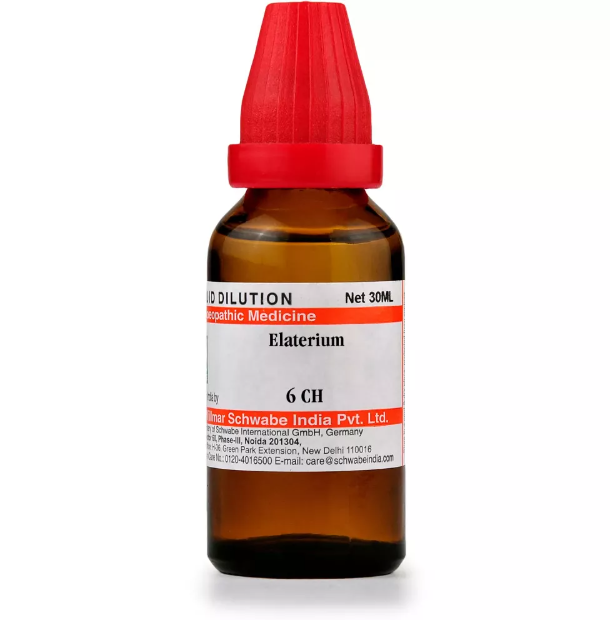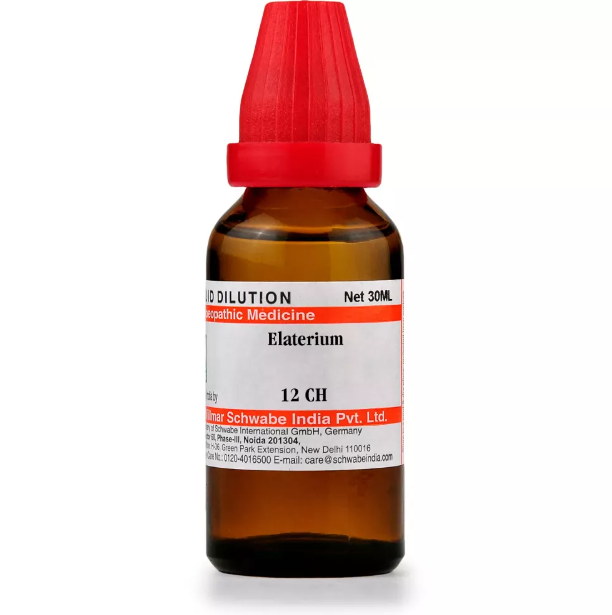ELATERIUM-ECBALIUM 6C, 12C, 30C, 200C, 1M, 10M USES AND SYMPTOMS
 Elaterium-Ecballium
Elaterium-Ecballium
(Squirting Cucumber)
Elat.
This remedy is highly effective for severe vomiting and diarrhea, especially when the evacuations are plentiful and watery. It is also useful for certain types of dropsy, characterized by marked yawning and stretching. It helps with beriberi, choleraic conditions, urticaria, and mental disorders resulting from suppressed malaria. There is an uncontrollable urge to wander at night and sensitivity to damp weather.
Stomach: Nausea and vomiting with significant weakness and gripping pain in the bowels.
Rectum: Watery, abundant, forceful diarrhea; frothy and olive green, accompanied by abdominal pain.
Extremities: Sharp pain in fingers, thumbs, knees, toes, and instep. Gouty pain in the great toes, extending down the extremities, and hip joint pain associated with diarrhea. Arthritic nodules are present.
Fever: Chills accompanied by yawning and stretching, with pain in extremities that extends to fingers and toes, and spurting diarrhea.
Skin: Stinging, burning, and smarting sensations. Dropsical conditions and urticaria from suppressed intermittent fever. The skin may turn an orange color.
Modalities: Symptoms worsen from exposure to damp ground.
Relationship: Compare with Bryonia, Croton tiglium, Gambogia.
Dose: Use the third to thirtieth potency.
SYMPTOMS OF ELATERIUM-ECBALIUM
Stomach:
Nausea and vomiting with significant weakness
Gripping pain in the bowels
Rectum:
Watery, abundant, forceful diarrhea
Frothy, olive green diarrhea with abdominal pain
Extremities:
Sharp pain in fingers, thumbs, knees, toes, and instep
Gouty pain in the great toes
Pain extending down the extremities
Hip joint pain associated with diarrhea
Arthritic nodules
Fever:
Chills with yawning and stretching
Pain in extremities, extending to fingers and toes
Chills and fever with spurting diarrhea
Skin:
Stinging, burning, and smarting sensations
Dropsical conditions
Urticaria from suppressed intermittent fever
Orange-colored skin
Modalities:
Symptoms worsen from exposure to damp ground
selection of the potency
Individualization:
- Homeopathy is based on the principle of treating the individual, not just the disease. The unique symptoms and characteristics of the person are crucial in determining the most suitable potency.
Intensity of Symptoms:
- The intensity of the symptoms guides the choice of potency. If the symptoms are intense and acute, a lower potency (e.g., 6C, 30C) might be considered. For chronic conditions with less intensity, higher potencies (e.g., 200C, 1M) may be appropriate.
Sensitivity of the Patient:
- Some individuals are more sensitive to homeopathic remedies, while others may require higher potencies. The practitioner considers the patient’s sensitivity when selecting the potency.
Acute vs. Chronic Conditions:
- Lower potencies are often used for acute conditions, while higher potencies may be considered for chronic or long-standing issues.
Previous Response to Potencies:
- The patient’s response to previous homeopathic treatments helps guide the choice of potency. If a particular potency has been effective in the past, it may be repeated or adjusted as needed.
Vital Force and Susceptibility:
- Homeopathy views illness as a disturbance in the vital force. The practitioner assesses the patient’s overall vitality and susceptibility to determine the appropriate potency.
Aggravation or Amelioration:
- The direction of the symptom response (aggravation or amelioration) after taking a remedy can influence the choice of potency.
Miasmatic Considerations:
- In classical homeopathy, the concept of miasms (inherited disease tendencies) is considered. The practitioner take this into account when selecting the potency.
Practitioner Experience:
- The experience and preference of the homeopathic practitioner play a role. Some practitioners may have success with certain potencies based on their clinical experience.
SAFETY INFORMATION
- Do not exceed the recommended dose by physician
- Keep out of the reach of children
- Store in a cool dry place away from direct sunlight
- Maintain half an hour gap between food/drink/any other medicines and homoeopathic medicine
- Avoid any strong smell in the mouth while taking medicine e.g. camphor, garlic, onion, coffee, hing
Medicine images use for reference only selection of homeopathic medicine depends on the individual’s specific symptoms and overall constitution. Moreover, homeopathy is a holistic system of medicine that treats the individual as a whole. In addition to addressing the physical symptoms, it takes into account the emotional and mental state of the person. Consequently, it’s crucial to consult with a qualified homeopathic practitioner for personalized treatment.
The information provided on this website is intended solely for educational purposes. Always seek the advice of your physician or other qualified health provider.
